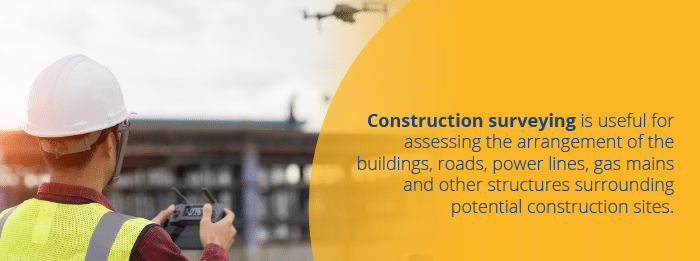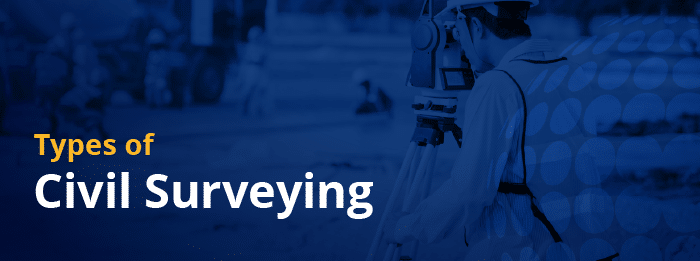Civil surveying is essential for the success of many construction projects, from residential and commercial buildings to infrastructure. It gives project managers and engineers the geographical information they need to build a structure that will stand up reliably in the local terrain and helps them map out how their project should unfold.
Within civil surveying projects, 3D modeling using survey data is a vital technique. The Federal Highway Administration recently analyzed an interchange project in Milwaukee, Wisconsin, and found that the use of 3D modeling reduced operational costs by up to 30.5 percent, especially in the construction of general structures, drainage and bridges.
But what is civil surveying, exactly, and what different forms does it take for different projects? In this guide, we’ll discuss what surveying in civil engineering is, its purpose and how different types of new technology help accomplish civil surveying goals.
Fundamentals of Civil Surveying for Project Success
Civil surveying is an engineering operation that involves assessing and recording details about an area of land. These observations can then be used to help plan construction projects.
The main purpose of surveying in civil engineering is to determine the three-dimensional relationships between different locations. Knowing information like the distances and angles between points and lines helps engineers determine how to draw up plans for public buildings, homes, roads, bridges and a variety of other construction and infrastructure projects.
The points that engineers measure are often located on the surface of the earth, though they can also be located in space. Because intricate, precise spatial relationships and boundary lines are so integral to this process, civil surveying draws on aspects of different disciplines, from mathematics to geography to law.
Civil surveying also involves specific equipment and GPS data acquired from satellites. High-precision electromechanical and optical equipment is also a necessity for ensuring measurements are accurate.
Elevate Your Construction Project With Expert Civil Surveying
Looking to kick-start your construction project? At Take-Off Professionals, our experienced in-house engineers offer tailored civil surveying solutions for commercial sites, residential sites, and road work operations.
The Critical Impact of Civil Surveyors in Construction
So, what is the importance of surveying to civil engineers? Surveying gives civil engineers a complete story of the land. It reveals details about topography, existing structures, natural elements and concealed conditions, all of which are essential to know before designing and proposing a project. Data from surveying enables civil engineers to understand site limitations and possibilities.
Civil surveying is useful in a tremendous variety of different applications across industries and project scopes. A few uses include:
- Creating maps: Surveying is all about data, and with that data, engineers can generate topographical or marine navigational maps that provide needed accuracy for project development.
- Preparing plots: Engineers can use surveying to determine boundary lines, calculate alignment and accomplish other tasks to prepare plots for various project requirements.
- Planning for new projects: Construction surveying enables engineers to inspect high-risk areas, ensure safety, conduct impact tests and determine optimal structure placement as they begin planning new projects.
- Estimating projected pathways: Data from surveying provides the information engineers need to estimate effective paths for roads, railways, power lines and irrigation systems.
- Assisting with land disputes: Surveying allows civil engineers to assess and record the boundaries of different properties to determine land ownership and settle legal disputes.
- Analyzing topography: Engineers can gather valuable information about terrain levels, elevation changes, existing structures and more from the data surveying provides to improve project efficiency and safety.
- Assessing existing structures: Data can reveal the position of existing structures like highways, canals, dams and bridges so engineers can understand what new structures will work within an area and which will not.
- Planning and constructing mines: Surveying can help engineers find underground resources, enabling them to effectively scope out potential locations and discover information about mine and tunnel dimensions.
- Preparing for military operations: Data from land surveys can assist with military operations and engagements by helping prepare maps and detailed plans that support various mission types.
- Charting navigational routes: A survey can determine safe navigation routes on land and water by measuring angles, finding distances and calculating positions.
Top Three Advantages of Professional Civil Surveying
Because a construction survey performs so many functions, it’s a vital component of any civil engineering project. It provides crucial information needed in multiple project stages, from site inspections and planning to impact monitoring and risk assessments. Civil surveying offers the data engineers require to understand natural features and human construction and develop effective plans.
Surveying offers three main benefits:
- Improved safety: Surveying assesses risk areas and hazards on a work site, enabling civil engineers to identify and resolve potential safety issues early on in a project. Surveying data can provide the necessary information to ensure structures are safe and protect the surrounding environment. Surveying technology can also increase job site safety through innovative tools.
- Enhanced efficiency: Civil engineers can improve their project’s efficiency with surveying data. Precise measurements can decrease errors and streamline operations such as earthmoving to save time, money and effort. Surveying helps engineers ensure structures are placed in optimal positions for better site preparation.
- Increased accuracy: Surveying provides accurate data about every aspect of the project site to help civil engineers draft comprehensive proposals. Better accuracy leads to better preparation, value estimation and project outcomes. Land surveying also enables engineers to establish accurate boundaries that prevent legal disputes and save time.
Tracing the Evolution of Civil Surveying Practices
The history of civil surveying goes back to ancient times. Egyptians used geometry to reestablish farm boundaries after dramatic flooding along the Nile River, and they used surveying techniques to design and construct the massive, geometrically precise pyramids at Giza, one of the wonders of the ancient world.
During Roman times, the role of civil surveying took on a prominent place in society, becoming an established profession. Land surveyors created the measurement systems they needed to evaluate and create a tax record of the lands they had conquered.
In the eighteenth century, European surveyors developed the technique of triangulation when they realized they could use different angle measurements taken from different places to pinpoint a precise location. And as the British colonized Australia and New Zealand, they used new tools such as measuring wheels, Gunter’s chains, Kater’s compasses and circumferentors, though they also resorted to measuring out paces by foot when necessary.
Gradually, tools like Gunter’s chain — which measures a precise 66 feet, or 1/80th of a mile — gave way to steel bands and invar tapes, and later to electromagnetic distance measurement (EMD) and global positioning satellite (GPS) equipment. Likewise, compasses gave way to theodolites — instruments that measured horizontal and vertical angles with a rotating telescope – which in turn made way for total stations that took measurements of angles and distance with a solo instrument.

Diverse Disciplines within Civil Surveying
Although construction is the most common type, engineers need to survey a wide range of features, from mountains to oceans to rivers. Engineers use several different types of civil engineering surveys, including:
- Construction surveying: Construction surveying is useful for assessing the arrangement of the buildings, roads, power lines, gas mains and other structures surrounding potential construction sites. Analyzing this information makes it easier to plan construction projects.
- Deformation surveying: Deformation surveying helps to establish if a geographical or man-made feature, such as a road, foundation, coastline or river, is changing shape. In deformation surveying, engineers record the three-dimensional coordinates of specific points. After some time has elapsed, they record the coordinates again to see if they have changed. A comparison of the two data sets can reveal if deformation or movement has occurred.
- Geological surveying: Geological surveying maps out features of the physical landscape, such as rivers, valleys, mountains and more. Satellite data is essential for geological surveying, and engineers frequently use satellite data or aerial photographs to help them in their work.
- Hydrographic surveying: Hydrographic surveying is similar to geological surveying, but it maps out coastlines specifically. Accurate hydrographic surveying is crucial to the work of the Coast Guard and any marine rescue operations. It also helps create navigational maps for sailors and assists conservationists in managing coastal resources.
- Topographic surveying: Topographic surveying analyzes the shape and physical features of a particular landscape. Engineers assess the height of different geographical coordinates and then draw contour lines to indicate areas of the same elevation. They can then use these findings to create topographical maps and to assess terrain for future building or infrastructure projects.
Technological Integration in Modern Civil Surveying
Since ancient times, engineers have developed a host of tools to help them survey all types of features. As surveying needs have evolved, so has technology. Surveying devices have changed and adapted to modern needs to bring engineers the increased accuracy and speed they require to ensure safety and efficiency for a variety of project types.
Significant Technological Shifts in Civil Surveying
Technological advancements have had a significant effect on the surveying industry, enabling surveyors to do more with less. Instead of multiperson teams carrying around large, complex and heavy equipment, surveyors can work alone or in small groups with minimal equipment. Surveying simplification has brought about important changes such as:
- Greater accuracy: Modern technology has improved accuracy in several ways, from the way data is gathered to the way it is recorded. Devices can accurately measure terrain, however uneven or difficult to access, and instantly record the data. These devices reduce chances for human error and provide precise measurements that improve overall accuracy on the job site.
- Increased speed: Many devices can produce accurate results in a matter of hours, saving time on data collection and enabling engineers to get to work sooner. Most modern surveying technology requires little effort and time to use, also helping to decrease in-field time. Surveying large areas is easier and quicker with technology that can gather thousands of data points in a second.
- Broader scope: Surveying technology can expand project scopes, enabling engineers to survey water and airspace in addition to land. Many devices allow for remote surveying to increase survey areas, especially for difficult-to-reach places. Surveying technology can quickly, accurately and safely assess areas and gather data for a wide variety of project types.
- Improved efficiency: Modern surveying devices have simplified the surveying process to enhance job site efficiency and productivity. They reduce labor requirements since most devices only need one or two operators, and they contribute to lower labor and equipment maintenance costs. Surveying technology also allows workers to continue working with minimal interruption.
- Expanded opportunities: Because surveying technology delivers more accurate data faster than ever before, engineers have more opportunities to innovate. Surveying devices provide ample information to maximize space and exceed project expectations. Engineers have more data and resources to ensure buildings, roads and other construction projects are sturdy, reliable and safe.
Cutting-Edge Tools Transforming Civil Surveyor Roles
In modern civil surveying, different types of technology are available to meet unique project requirements. These technology advancements offer greater precision and better data visualization, giving engineers the detailed information they need to ensure safety, efficiency and accuracy.
Technology used in current civil surveying operations includes:
- Computer-assisted drawing (CAD): Once engineers have gathered survey data, computer-assisted drawing helps turn that data into a useful visual representation, such as a map or three-dimensional model. CAD allows for a greater level of precision and detail than could not be achieved with manual sketching or drawing.
- Global positioning satellite data: GPS survey data is crucial for civil surveying because it allows for the pinpointing of precise locations and coordinates. Where a visual assessment alone would be insufficient for determining whether a corner had shifted or a foundation had sunk, the pinpoint accuracy of GPS data allows engineers to know for sure.
- Aerial photogrammetry: Drones are often useful for the aerial photography necessary in civil engineering. Once they have a number of aerial photographs of the landscape or site in question, engineers can use aerial photogrammetry to extract topographical data from the photos. Aerial photogrammetry combines multiple shots from different angles to create an accurate 3D model.
- Point cloud modeling: To develop accurate 3D survey models, engineers also often create a point cloud or a set of three-dimensional data points. Surveyors use 3D laser-scanning technology to generate a data map of the area they wish to model. Once they have data that represents every surface they need, they can then bring the points together through point cloud modeling into an accurate and detailed 3D model.
Visionary Perspectives: The Civil Surveying Landscape Ahead
Surveying techniques and technology have come a long way since the days of the ancient Egyptians, and they will continue to advance and adapt as surveying and construction demands increase and change. Upcoming technological advancements will be integral to the successful and effective future of surveying.
Innovations on the Horizon for Civil Surveying
Recent technological developments that are increasing in popularity within the surveying industry include:
- LiDAR: Light detection and ranging (LiDAR) is a growing and innovative technology that enables engineers to gather data quickly and accurately. Some systems provide real-time point clouds, offering the speed and data accessibility engineers need to keep projects moving forward. LiDAR technology advancements strive to provide precision and flexibility that benefit a wide variety of industries and project scopes.
- Mobile 3D mapping: Improvements in mobile 3D mapping open several opportunities for increasing project safety, accuracy and efficiency. This technology enables surveyors to map difficult locations with versatile and portable equipment. Mobile 3D mapping also offers real-time results for faster, more streamlined decision-making.
- Drones: Unmanned aerial vehicles (UAVs) are increasingly common on construction work sites as they become more accessible and affordable. Drones can cover large, difficult-to-reach areas quickly and efficiently, enabling greater site safety and productivity. As UAVs continue to advance, engineers can experience improved accuracy and speed in surveying and project development.
- Data storage: Advancing technology gathers more and more data that needs to be stored and managed. Cloud storage is becoming increasingly popular and even necessary as surveyors search for a scalable data storage solution. Data storage will be a top priority as surveying technology continues to evolve.
How Emerging Technologies Reshape Civil Surveying
As technology advances, the civil surveying industry can expect to see changes in aspects such as:
- Speed: Technological advancements lead to more efficient devices that improve surveying speed. Surveying technology will only get faster at collecting data and producing results for streamlined operations.
- Expertise: Changes in technology will mean changes in required expertise. A valuable surveyor will be one who stays updated on the latest technology trends and can operate innovative devices such as UAVs.
- Safety: Improvements in technology can lead to increased job site safety. Many surveying devices can travel into or scan dangerous areas, enabling surveyors to remain safe while still collecting valuable data.
- Decision-making: Innovative tools will continue to make data collection quick and precise. This consistently accurate and accessible data will allow engineers and clients to make valuable decisions early on in project development to enhance results.
TOPS: Your Ally in Precision Civil Surveying
When you need 3D modeling expertise to get a construction project or bid off the ground, Take-Off Professionals can help. All our engineers are full-time employees, never contractors, so you’ll always work with someone who is fully integrated into the company, experienced with our techniques and invested and in the success of your operation.
We also stand apart from the competition because we don’t manufacture or sell hardware or software — we specialize only in takeoffs. That specialization has allowed us to develop an unparalleled wealth of technical expertise and vision in civil surveying. We can optimize our work for commercial sites, residential sites, and road work and highway operations, so you’ll always get the customized surveying solution that works best for you.
Check out our compelling list of reasons you should work with us, and then contact us today to learn more.


